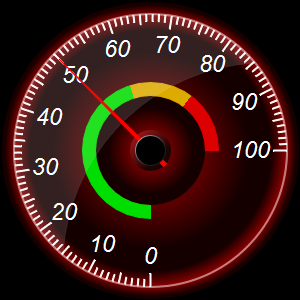



This examples demonstrates various shading effects to create round meters with a neon look and feel. It also demonstrates how to create meters that can easily be resized.
In this example, the code uses a single size parameter as input, and it derives all the other sizes, such as the radius of the various parts of the chart, the font size, line widths and tick lengths. This allows the chart to be easily resized by changing only one parameter.
For the colors, apart from black and white, the code only uses a single color as input.
BaseChart.adjustBrightness is used to create brighter or darker versions of that color, and
AngularMeter.relativeRadialGradient is used to combine them in gradients.
[File: phpdemo/neonroundmeter.php]
<?php
require_once("../lib/phpchartdir.php");
function createChart($viewer, $chartIndex)
{
# The value to display on the meter
$value = 50;
# The main color of the four meters in this example. The other colors and gradients are derived
# from the main color.
$colorList = array(0x007700, 0x770077, 0x0033dd, 0x880000);
$mainColor = $colorList[$chartIndex];
#
# In this example, we demonstrate how to parameterized by size, so that the chart size can be
# changed by changing just one variable.
#
$size = 300;
# The radius of the entire meter, which is size / 2, minus 2 pixels for margin
$outerRadius = (int)($size / 2 - 2);
# The radius of the meter scale
$scaleRadius = (int)($outerRadius * 92 / 100);
# The radius of the inner decorative circle
$innerRadius = (int)($scaleRadius * 40 / 100);
# The width of the color scale
$colorScaleWidth = (int)($scaleRadius * 10 / 100);
# Major tick length
$tickLength = (int)($scaleRadius * 10 / 100);
# Major tick width
$tickWidth = (int)($scaleRadius * 1 / 100 + 1);
# Label font size
$fontSize = (int)($scaleRadius * 13 / 100);
#
# Create an angular meter based on the above parameters
#
# Create an AngularMeter object of the specified size. In this demo, we use black (0x000000) as
# the background color. You can also use transparent or other colors.
$m = new AngularMeter($size, $size, 0x000000);
# Set the default text and line colors to white (0xffffff)
$m->setColor(TextColor, 0xffffff);
$m->setColor(LineColor, 0xffffff);
# Set meter center and scale radius, and set the scale angle from -180 to +90 degrees
$m->setMeter($size / 2, $size / 2, $scaleRadius, -180, 90);
# Background gradient with the mainColor at the center and become darker near the border
$bgGradient = array(0, $mainColor, 0.5, $m->adjustBrightness($mainColor, 0.75), 1,
$m->adjustBrightness($mainColor, 0.15));
# Fill the meter background with the background gradient
$m->addRing(0, $outerRadius, $m->relativeRadialGradient($bgGradient, $outerRadius * 0.66));
# Fill the inner circle with the same background gradient for decoration
$m->addRing(0, $innerRadius, $m->relativeRadialGradient($bgGradient, $innerRadius * 0.8));
# Gradient for the neon backlight, with the main color at the scale radius fading to transparent
$neonGradient = array(0.89, Transparent, 1, $mainColor, 1.07, Transparent);
$m->addRing((int)($scaleRadius * 85 / 100), $outerRadius, $m->relativeRadialGradient(
$neonGradient));
# The neon ring at the scale radius with width equal to 1/80 of the scale radius, creating using
# a brighter version of the main color
$m->addRing($scaleRadius, (int)($scaleRadius + $scaleRadius / 80), $m->adjustBrightness(
$mainColor, 2));
# Meter scale is 0 - 100, with major/minor/micro ticks every 10/5/1 units
$m->setScale(0, 100, 10, 5, 1);
# Set the scale label style, tick length and tick width. The minor and micro tick lengths are
# 80% and 60% of the major tick length, and their widths are around half of the major tick
# width.
$m->setLabelStyle("Arial Italic", $fontSize);
$m->setTickLength(-$tickLength, -(int)($tickLength * 80 / 100), -(int)($tickLength * 60 / 100));
$m->setLineWidth(0, $tickWidth, (int)(($tickWidth + 1) / 2), (int)(($tickWidth + 1) / 2));
# Demostrate different types of color scales and glare effects and putting them at different
# positions.
$smoothColorScale = array(0, 0x0000ff, 25, 0x0088ff, 50, 0x00ff00, 75, 0xdddd00, 100, 0xff0000);
$stepColorScale = array(0, 0x00dd00, 60, 0xddaa00, 80, 0xdd0000, 100);
$highColorScale = array(70, Transparent, 100, 0xff0000);
if ($chartIndex == 1) {
# Add the smooth color scale just outside the inner circle
$m->addColorScale($smoothColorScale, $innerRadius + 1, $colorScaleWidth);
# Add glare up to the scale radius, concave and spanning 190 degrees
$m->addGlare($scaleRadius, -190);
} else if ($chartIndex == 2) {
# Add the high color scale at the default position
$m->addColorScale($highColorScale);
# Add glare up to the scale radius
$m->addGlare($scaleRadius);
} else {
# Add the step color scale just outside the inner circle
$m->addColorScale($stepColorScale, $innerRadius + 1, $colorScaleWidth);
# Add glare up to the scale radius, concave and spanning 190 degrees and rotated by -45
# degrees
$m->addGlare($scaleRadius, -190, -45);
}
# Add a red (0xff0000) pointer at the specified value
$m->addPointer2($value, 0xff0000);
# Set the cap background to a brighter version of the mainColor, and using black (0x000000) for
# the cap and grey (0x999999) for the cap border
$m->setCap2($m->adjustBrightness($mainColor, 1.1), 0x000000, 0x999999);
# Output the chart
$viewer->setChart($m, SVG);
}
# This example includes 4 charts
$viewers = array();
for ($i = 0; $i < 4; ++$i) {
$viewers[$i] = new WebChartViewer("chart$i");
createChart($viewers[$i], $i);
}
?>
<!DOCTYPE html>
<html>
<head>
<title>Neon Round Meters</title>
<!-- Include ChartDirector Javascript Library to support chart interactions -->
<script type="text/javascript" src="cdjcv.js"></script>
</head>
<body style="margin:5px 0px 0px 5px">
<div style="font:bold 18pt verdana;">
Neon Round Meters
</div>
<hr style="border:solid 1px #000080; background:#000080" />
<div style="font:10pt verdana; margin-bottom:1.5em">
<a href="viewsource.php?file=<?=basename(__FILE__)?>">View Chart Source Code</a>
</div>
<!-- ****** Here are the chart images ****** -->
<?php
for ($i = 0; $i < count($viewers); ++$i) {
echo $viewers[$i]->renderHTML(), " ";
}
?>
</body>
</html>
© 2022 Advanced Software Engineering Limited. All rights reserved.



